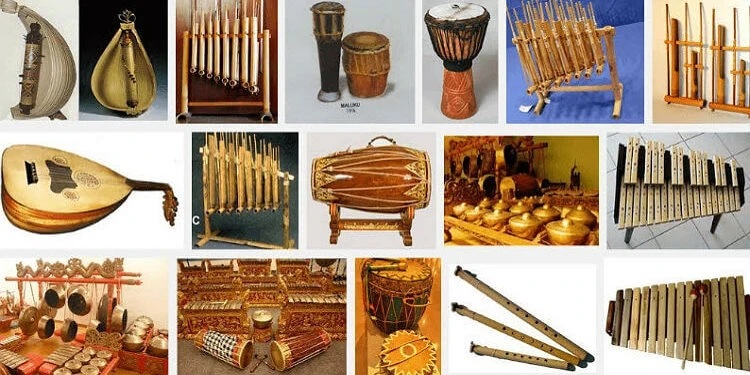
Each region of Indonesia has its authenticity in culture, food, and even in musical arts. Indonesians have a deep love for music, especially when it resonates loudly from traditional musical instruments. UNESCO recognizes Indonesia's superpower in the field of culture and the arts.
This article will delve into the original musical instruments native to Indonesia that have endured through time, as well as those created in other countries but have found a place in Indonesia.
Birth of Music with an Unusual Instrument - Sasando

Sasando is a traditional musical instrument from Nusa Tenggara Timur (NTT) on East Java, played with both hands. Sasando means "something trembling" due to the presence of a large number of strings embedded in the tube. Some have 28, some 58, and even 84 strings. The instrument is made of bamboo and represents a resonant container in a semicircular shape, supports (senda), wooden pads to hold the strings, and a long tube made of special bamboo.
Currently, Sasando is also developed using electricity, so although this instrument falls into the traditional category, it can keep up with modernity. Playing Sasando involves plucking the strings with both hands but in opposite directions.
To immerse yourself in the history and feel the melody flowing from this Javanese instrument, you can check YouTube. The sound is delightful!
There is an opportunity to buy Sasando online on Tokopedia. Prices range from 150,000 to 2 million Indonesian Rupiah. Indonesians still love to tell the fable about the circumstances in which this new bamboo instrument was born.
Fairy Tale
It all started with the story of a Javanese man named Sangguana, who found himself on the island of Ndana and fell in love with the king's daughter. Upon learning of this, the king gave Sangguana conditions to make a musical instrument different from others already known. Sangguana dreamed of playing a strange musical instrument. The sound was melodious and light, evoking beautiful emotions.
Sangguana decided to turn the dream into reality and crafted Sasando. The king was amazed by the beautiful, heart-touching melody and gave his daughter in marriage to this musical fantasizer. Whether it's truth or fiction, we don't know for sure, but what matters is that Sasando remains a favorite in many regions of Indonesia.
Tifa - Musical Instrument from Papua
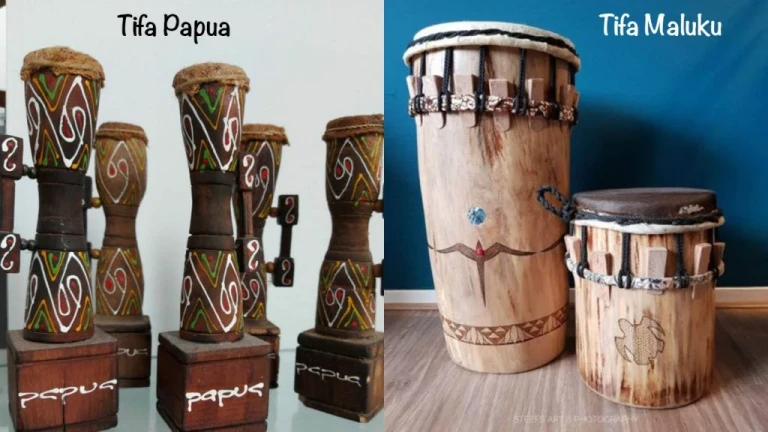
The "Tifa" is a traditional musical instrument originating from Eastern Indonesia, specifically from the regions of Papua and Maluku. It has the shape of a drum. There's a distinction between the Maluku and Papua variants – the Maluku tifa has a tubular shape without a handle, while the Papua tifa has a more curved middle and comes with a handle, often adorned with decorative ethnic carvings. The drum is covered with dried deer skin, attached to one side of the instrument. The skin, surrounded by rattan, serves as a membrane for a snug fit and comfortable use. In Papua, the tifa accompanies traditional dances and songs. Despite its wild appearance, the performances are well-organized.
A similar drum called "ganda" or "kanda" shares the same form but is smaller and thinner. The striking technique and skill depend on the player and the type of event it is used for.
Craftsmen create tifa not only for adults but also for children, with prices ranging from 70 thousand to 2 million Indonesian rupiahs, depending on size, material, and the intricacy of decorative carvings. Various options are available on Shopee.
The "Beduk" is a drum that signifies a large drum used in Islamic mosques (masjid) to announce prayer times (solat). These instruments can also be purchased online in various sizes, from large to miniature souvenirs, with prices ranging from 11 to 120 thousand rupiahs.
The "Gimba" is used to convey specific events such as sad news or natural disasters. Each strike on the gimba signifies something and is used to accompany dances, especially during ceremonies and competitions. It blends with other musical instruments, such as the "lalove."
The "Dol" is a traditional musical instrument originating from Bengkulu, producing distinct sounds. In suvena technique, it is played at a slow pace during funeral processions, while "tamatam" is played in joyful atmospheres, and "suvari" is used on percussion instruments during the Topper's parade.
Kendang is an instrument similar to a drum, originating from East Java. It is often used in traditional dances, jazz, and contemporary music, with many musicians employing drums as accompaniment.
Rebana is a percussion instrument resembling tambourines, used in Islam to accompany prayer verses. Some also use it for wedding celebrations or Thanksgiving Day.
Rebana Centers across the country offer a variety of options for those wanting to purchase directly, with orders shipped nationwide and internationally. For price and orders, contact directly at 0852-2963-3401 or visit the official website: http://rebanacentre.com/. Alternatively, it can be bought online on Shopee.
Kompaṅg, similar to Rebana, hails from the Lampung region. Crafted from goat skin or wood, it comes in various musical variations. Instruments are available on Tokopedia, Shopee, with prices ranging from 30 thousand to a million rupiahs.
Burda, a traditional musical instrument from South Sumatra, resembles a drum and is made from animal skin and jackfruit wood. Played by striking the palm on the skin's surface.
Gamelan is a combination of several traditional Indonesian musical instruments.

The Balinese gamelan differs in shape and has a faster, explosive, and dynamic sound compared to the Javanese. It is often accompanied by hand cymbals known as "cheng-cheng." Different variations of this instrument include gendang, gong, bonang, demung. Gamelan Waiya is an ancient Balinese gamelan type that existed until the 15th century.
For Balinese people, gamelan is integral to daily life, symbolizing harmony. UNESCO recognized gamelan as a cultural heritage item in 2014. Gamelan has gained popularity beyond Indonesia, with music schools established in the USA, England, Australia, and Canada.
In Bali, a street parade on June 23, 2016, featured beautiful Balinese people in vibrant costumes playing traditional gamelan music. In 2023, a concert in Bali showcased traditional gamelan playing and accompanying dances, offering an exhilarating experience for those accustomed to its explosive sound.
Gamelan can be purchased online in miniature and large sizes, suitable for home entertainment.
Tatabuangan is made of breadfruit wood.
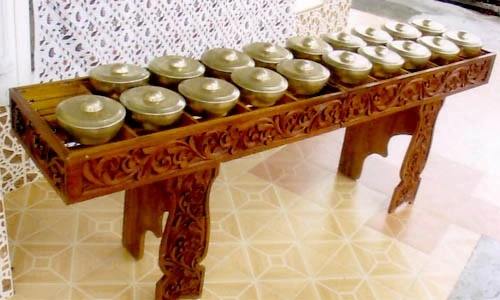
Tatabuang (tabuh, meaning drum play) is a traditional musical instrument consisting of a series of small gongs (mungmung, momo) made of brass or metal, arranged horizontally or as a xylophone with metal blades, wood, or bamboo. It is part of the Southeast Asian culture, historically played in the Malay Archipelago, including the Philippines, Eastern Indonesia, Eastern Malaysia, Brunei, and Timor.
This musical instrument originates from the Lamanele region in East Flores. Crafted from the wood of the breadfruit tree, its central part is removed to serve as a resonant container. There's a similar instrument called "totobuang" from Papua, Maluku. The music can be listened to here. Influenced by Hinduism, Buddhism, Islam, and Christianity, this instrument continued the tradition of gongs. Such music is heard at weddings and other significant events.
Bende, a type of percussion instrument from Tapanuli, North Sumatra, is made of metal such as bronze, brass, or aluminum alloy. It has existed for centuries, used as accompaniment at various traditional events, weddings, and gatherings. It looks like a frying pan with a stick for striking.
You can listen to the music for a few more seconds out of curiosity, but enduring such loud sounds for an extended period might be challenging. However, Indonesians are not only accustomed to it but also enjoy it.
Angklung, a UNESCO-recognized cultural heritage of Indonesia, originates from West Java.

Made from bamboo tubes, it produces a distinct sound when vibrated or shaken. Harmonious sounds require many people playing the angklung together, and the sound of a single angklung isn't particularly interesting. It consists of 10 different instruments and is often used in important ceremonies alongside gongs or gamelan to enhance sounds, highlighting the significance of the celebration.
For detailed information on a professional Balinese who skillfully crafts angklung from white and black bamboo, visit Balitaksu.com. Whether angklung sounds beautiful or not is subjective and can be judged by listening at leisure.
Angklung is considered one of Indonesia's cultural charms, attracting foreign tourists. One notable Indonesian tourist destination featuring Angklung is the Saung Angklung Udjo art studio in Bandung.
Moreover, Angklung, like gamelan, is recognized as a UNESCO World Cultural Heritage, included in the Representative List of the Intangible Cultural Heritage of Humanity.
Official website: angklung-udjo.co.id. It can be purchased online at an affordable cost, ranging from approximately 13 thousand to 250 thousand rupiahs.
Colintang, known for its beautiful sound.
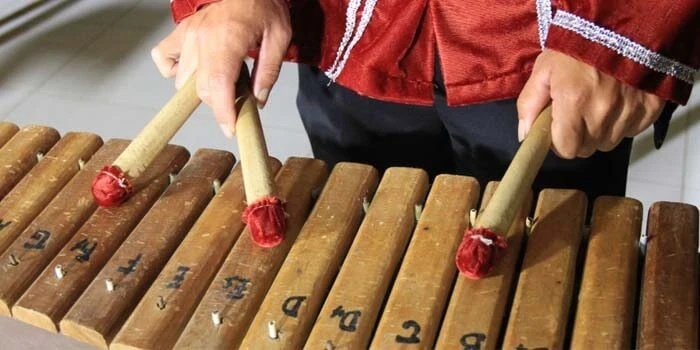
Gained recognition from North Sulawesi to various countries worldwide. In one country, Colintang successfully entertained guests at a dinner for the Queen of Denmark at the Presidential Palace.
The name "colintang" comes from the notes it produces: low notes "tong," high notes "ting," and middle notes "tang." The sounds resemble "ber tong ting tang" or locally known as "maimo kumolintang." Gradually, this expression was replaced by colintang.
In ancient times, colintang music was used for traditional ritual ceremonies related to ancestor worship. Later, it accompanied participants during dances, songs, or musical performances. Nowadays, colintang is played in pop, jazz, and rock styles.
Made from various types of special wood, light but quite dense with parallel lines, colintang resembles a xylophone but is more sophisticated. Online stores offer a limited selection, mainly for children, at an affordable cost.
Doli-Doli
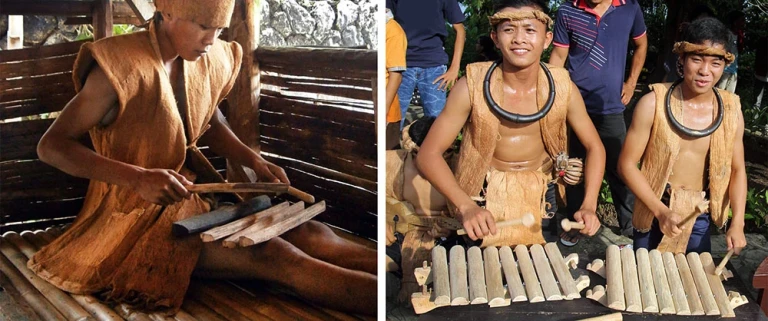
Doli-doli is a traditional musical instrument from Nias, North Sumatra, made of 4 or more wooden slats. It is typically placed on the lap, and short wooden sticks are used to play it. A more complex version involves placing the slats on special stands. In the southern part of the country, this musical instrument is known as Doli-doli Hagita. On the mainland of Malaysia, locals refer to it as Kolintang, and it is sometimes combined with other traditional instruments like aramba and pakpak. There's a children's game of Doli-doli on YouTube.
Balinese Bamboo Rindik
Rindik is a traditional musical instrument from Bali, made of selected bamboo pieces. The bamboo pieces are spaced apart to produce different sounds.

History of Rindik
It all started with the people of Wengker (now Ponorogo), who revolted against the Majapahit kingdom. The Wengker people had a musical instrument called Angklung Reyog, which also served as a weapon. During an attack by the Demak kingdom, the Wengker people fled to Bali, bringing Angklung Reyog and Gamelan with them. When they arrived in Bali, they faced difficulties assembling the musical instrument due to some damaged parts. They managed to restore Angklung Reyog, and it began producing sounds similar to a xylophone. The musical instrument was finally named Rindik, which, in old Javanese, means "neat arrangement with minimal gaps."
The Rindik musical instrument consists of 11–13 neatly arranged bamboo pieces with spaces between them. Each bamboo piece has a different size and tone. In the past, Rindik on Bali was commonly used for the entertainment of common people, especially farmers. It also accompanied the dance performances of Joged Bumbung. Nowadays, Rindik is widely used, from weddings to cultural festivals. The cost of the instrument is approximately from 220 thousand to 1 million 360 thousand rupiahs.
Garantung is a musical instrument from the Batak province, North Sumatra, made of five tonal wooden strips. Classified as a xylophone, it is played with two sticks for the left and right hand.
Rebab – Similar to a violin
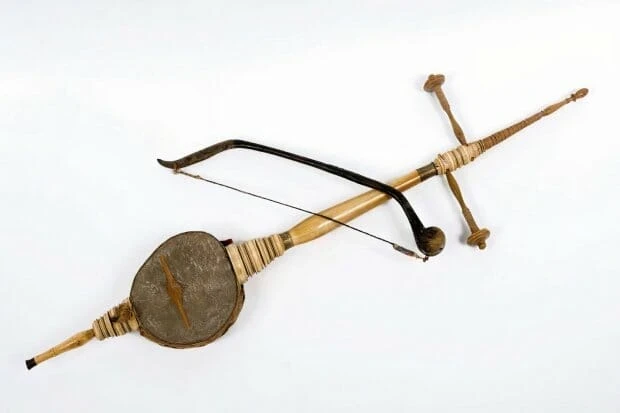
A one or two-stringed bowed (sometimes plucked) instrument widely used in the arts of Malaysia, Sumatra, Java, and Kalimantan. Rebab is also known as a chordophone. It is rounded, with two or three strings and a long neck, about 75 cm high. It is made from wood or elephant ivory. Originally brought by Arabs from the Middle East through Islamic trade routes, it then moved to Persia and India and finally reached the Indonesian archipelago. Although this instrument originated from outside, the Indonesian version has a different sound.
The playing technique of the instrument is adapted to the cultural customs and traditions of the Malay community. According to research, the instrument was depicted on the walls of the Borobudur temple, around the 11th century. Arabs called this musical instrument "rabab," and it was later perfected, immediately gaining widespread use. In the 8th century, through the Islamic Caliphate center in Cordoba, the Rebab musical instrument began to spread in Western Europe, resulting in the formation of the cello, later the violin. In India, it was called "Sarod" (plucked), and in Afghanistan, "Rubab."
One famous singer, Tansen, who was the court singer of the Mughal king Akbar, was also a skilled player of the Rebab.
Javanese people strive to prevent the disappearance of ancient musical instruments, so they don't forget to play and teach them to all Indonesians. Under the sounds of Rebab, people manage to sing, resulting in a nice performance. The instrument's price starts from 600 thousand rupiahs.
This Pix Musik store offers both Rebab and other musical instruments to choose from.
Keso-keso is a musical two-stringed instrument, similar to Rebab, but the difference lies only in the number of strings. It comes from Maluku, from the Tanimbar island. For the locals, Keso-keso is not just a musical instrument; it is their daily life, a symbol of culture and rich traditions. Despite not being very popular globally, it continues to thrive in the hearts of the Maluku people.
Keso-keso is made from natural, lightweight, and durable bamboo. Its shape is simple, with a long and thin hollow extending upwards. One of the things that makes keso-keso unique is its loud and raspy sound, as if calling the souls of ancestors hidden on the islands. It is played by a sweeping motion.
Gambus is a traditional Indonesian musical instrument originating from the Riau region, resembling a guitar in an oval shape. It is part of Malay customs and Arab culture.
Sape is a traditional stringed musical instrument, similar to a guitar, often used as an accompanying instrument at traditional Dayak events. The Dayak people are an indigenous ethnic group on the island of Kalimantan.
Panting is an instrument that has existed since the 18th century and was developed in the village of Rantau-Budjur, South Kalimantan. Its appearance coincided with the development of Japanese dance and was initially used only to accompany and complement the dance of Japanese dancers. The music began to be used in traditional dances in the South Kalimantan region and in new compositions. It is made from animal skin, wood, and strings are added later. Its shape resembles a smaller and thinner guitar without curves.
Siter is a musical instrument whose components resemble a guitar. The source of sound for the zither is strings. It is used to accompany Javanese Gamelan performances.
Flutes and Their Types
Lalove – a long flute used as an accompaniment to some regional or traditional dances. The instrument combines with other musical instruments: kadode, yori, mbasi-mbasi, kentonan. Lalove is also used during local traditional ceremonies, such as baliya.
There is also a similar flute called suling originating from West Java, made of bamboo and classified as a wind instrument, aerophone. It has a shape of approximately 30 cm with a diameter of 3 cm. There is a small hole in its body, which serves as a place for tone adjustment. The sound is reminiscent of a rough and piercing whistle.
Serune Kale – a musical instrument originating from the Nanggroe Aceh Darussalam region. By playing this small flute, you can regulate the sound with your fingers. It is made from a combination of wood, brass, and bronze, with a thin base that expands at the end.
In the city of Jambi, there is also a traditional musical instrument called seranko. This musical instrument is made from the head of a buffalo topper. Sounds are blown out of this musical instrument, similar to a clarinet. Seranko can produce a loud sound to remind the residents of Jambi of something important.
Saluang – a traditional wind instrument originating from West Sumatra. This instrument is similar to a flute but simpler, as it has only four holes. It is believed that in ancient times, saluangs had spells that could mesmerize the audience.
Serunai is the name of a wind instrument known in Indonesia as a traditional flute of the Minang community. A unique part of the flute is its expanding tube shape, which serves to increase the volume of the sound.
It is believed that the origin of such a flute comes from the name shehnai, originating from the Kashmir Valley on the plains of North India. The shehnai musical instrument is used for snake charming. The instrument is popular in Indonesia, Malaysia, and the Banjar community in Kalimantan.
The Smallest Indonesian Instrument
Kuriding or guriding is a typical musical instrument of the Banjar tribe, made from palm leaves, bamboo, and thin thread. You can play it by bringing it to your lips and stretching the vibrating string. On Shopee, there is a variety of prices and choices for this mini "harmonica," ranging from 25 thousand to 150 thousand rupiahs.
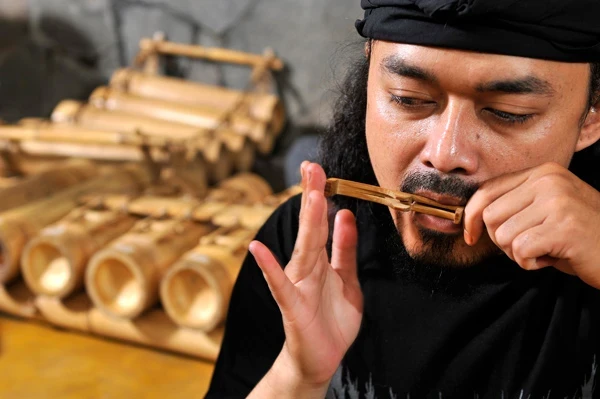
Pupuik is a musical instrument created from a buffalo horn. The ends are trimmed evenly to achieve a clean, shiny black form. The instrument is not used to accompany dances or singing but serves as a one-note whistle.
It is believed that the kèchapi originated in China, and later Indonesians created a similar instrument. The way to play it is similar to a harp, where the strings are plucked, producing a sound like a chordophone.
Talindèr or tolinde is a traditional musical instrument originating from South Sulawesi, although there are rumors that it initially originated in China. The musical instrument looks quite minimalist. It is made from solid wood, strings, and coconut shell. It has the shape of a buffalo or cow horn, leaning on a coconut shell. Talindèr is a sitar-type musical instrument since it has only one string. The uniqueness of the resonator lies in it being made from a coconut shell.

If you delve even deeper into the world of Indonesian musical instruments, you can find an extensive list, but they are not particularly popular or are simply similar to existing ones. The most well-known and UNESCO-recognized musical instruments in Indonesia are sasando, angklung, gamelan, kolintang, and tifa.
You can add one right now!